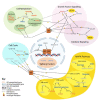Unravelling the Role of Kinases That Underpin Androgen Signalling in Prostate Cancer
- PMID: 35326402
- PMCID: PMC8946764
- DOI: 10.3390/cells11060952
Unravelling the Role of Kinases That Underpin Androgen Signalling in Prostate Cancer
Abstract
The androgen receptor (AR) signalling pathway is the key driver in most prostate cancers (PCa), and is underpinned by several kinases both upstream and downstream of the AR. Many popular therapies for PCa that target the AR directly, however, have been circumvented by AR mutation, such as androgen receptor variants. Some upstream kinases promote AR signalling, including those which phosphorylate the AR and others that are AR-regulated, and androgen regulated kinase that can also form feed-forward activation circuits to promotes AR function. All of these kinases represent potentially druggable targets for PCa. There has generally been a divide in reviews reporting on pathways upstream of the AR and those reporting on AR-regulated genes despite the overlap that constitutes the promotion of AR signalling and PCa progression. In this review, we aim to elucidate which kinases-both upstream and AR-regulated-may be therapeutic targets and require future investigation and ongoing trials in developing kinase inhibitors for PCa.
Keywords: androgen receptor; androgen-regulated genes; kinase; prostate cancer.
Conflict of interest statement
The authors declare no conflict of interest.
Figures


Similar articles
-
Androgen action in the prostate gland.Minerva Urol Nefrol. 2012 Mar;64(1):35-49. Minerva Urol Nefrol. 2012. PMID: 22402316 Review.
-
Unique targeting of androgen-dependent and -independent AR signaling in prostate cancer to overcome androgen resistance.FASEB J. 2020 Sep;34(9):11511-11528. doi: 10.1096/fj.201903167R. Epub 2020 Jul 26. FASEB J. 2020. PMID: 32713076
-
Androgen receptor remains critical for cell-cycle progression in androgen-independent CWR22 prostate cancer cells.Am J Pathol. 2006 Aug;169(2):682-96. doi: 10.2353/ajpath.2006.051047. Am J Pathol. 2006. PMID: 16877366 Free PMC article.
-
Identification of novel AR-targeted microRNAs mediating androgen signalling through critical pathways to regulate cell viability in prostate cancer.PLoS One. 2013;8(2):e56592. doi: 10.1371/journal.pone.0056592. Epub 2013 Feb 22. PLoS One. 2013. PMID: 23451058 Free PMC article.
-
Epitranscriptomic mechanisms of androgen signalling and prostate cancer.Neoplasia. 2024 Oct;56:101032. doi: 10.1016/j.neo.2024.101032. Epub 2024 Jul 20. Neoplasia. 2024. PMID: 39033689 Free PMC article. Review.
Cited by
-
Cyclin-dependent kinases as mediators of aberrant transcription in prostate cancer.Transl Oncol. 2025 May;55:102378. doi: 10.1016/j.tranon.2025.102378. Epub 2025 Mar 30. Transl Oncol. 2025. PMID: 40163908 Free PMC article. Review.
-
A compendium of Androgen Receptor Variant 7 target genes and their role in Castration Resistant Prostate Cancer.Front Oncol. 2023 Mar 1;13:1129140. doi: 10.3389/fonc.2023.1129140. eCollection 2023. Front Oncol. 2023. PMID: 36937454 Free PMC article. Review.
-
Cell Progression and Survival Functions of Enzymes Secreted in Extracellular Vesicles Associated with Breast and Prostate Cancers.Cells. 2025 Mar 21;14(7):468. doi: 10.3390/cells14070468. Cells. 2025. PMID: 40214422 Free PMC article. Review.
-
Dissecting the effects of androgen deprivation therapy on cadherin switching in advanced prostate cancer: A molecular perspective.Oncol Res. 2023 Jan 12;30(3):137-155. doi: 10.32604/or.2022.026074. eCollection 2022. Oncol Res. 2023. PMID: 37305018 Free PMC article. Review.
-
APOM Modulates the Glycolysis Process in Liver Cancer Cells by Controlling the Expression and Activity of HK2 via the Notch Pathway.Biochem Genet. 2025 Jan 4. doi: 10.1007/s10528-024-11013-y. Online ahead of print. Biochem Genet. 2025. PMID: 39754657
References
Publication types
MeSH terms
Substances
LinkOut - more resources
Full Text Sources
Other Literature Sources
Medical
Research Materials

